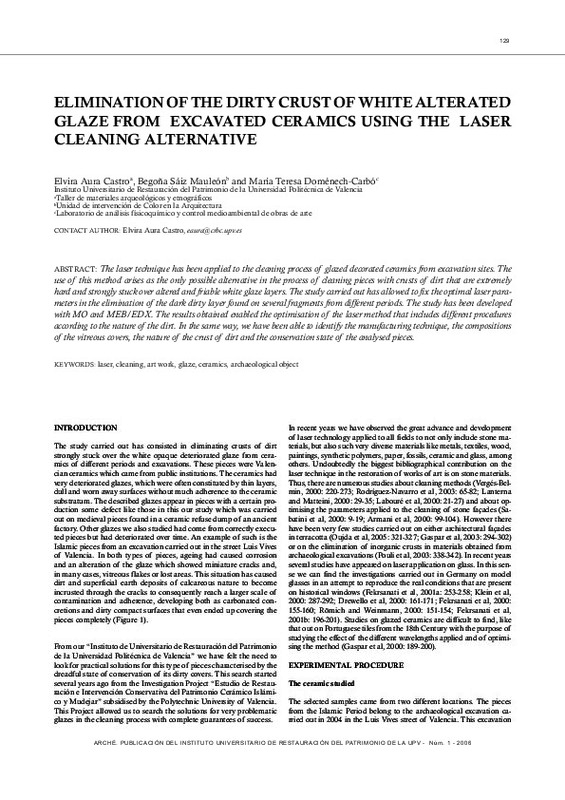JavaScript is disabled for your browser. Some features of this site may not work without it.
Buscar en RiuNet
Listar
Mi cuenta
Estadísticas
Ayuda RiuNet
Admin. UPV
Elimination of the dirty crust of white alterated glaze from excavated ceramics using the laser cleaning alternative
Mostrar el registro sencillo del ítem
Ficheros en el ítem
| dc.contributor.author | Aura Castro, Elvira
|
es_ES |
| dc.contributor.author | Saiz Mauleón, María Begoña
|
es_ES |
| dc.contributor.author | Domenech Carbo, Mª Teresa
|
es_ES |
| dc.date.accessioned | 2013-09-30T06:31:25Z | |
| dc.date.available | 2013-09-30T06:31:25Z | |
| dc.date.issued | 2006 | |
| dc.identifier.issn | 1887-3960 | |
| dc.identifier.uri | http://hdl.handle.net/10251/32436 | |
| dc.description.abstract | The laser technique has been applied to the cleaning process of glazed decorated ceramics from excavation sites. The use of this method arises as the only possible alternative in the process of cleaning pieces with crusts of dirt that are extremely hard and strongly stuck over altered and friable white glaze layers. The study carried out has allowed to fix the optimal laser parameters in the elimination of the dark dirty layer found on several fragments from different periods. The study has been developed with MO and MEB/EDX. The results obtained enabled the optimisation of the laser method that includes different procedures according to the nature of the dirt. In the same way, we have been able to identify the manufacturing technique, the compositions of the vitreous covers, the nature of the crust of dirt and the conservation state of the analysed pieces. | es_ES |
| dc.description.abstract | La técnica del láser se ha aplicado en el proceso de limpieza de cerámica vidriada y decorada procedente de excavaciones. El uso de este método se presenta como la única alternativa posible en el proceso de limpieza de piezas con capas de suciedad de gran dureza y fuertemente adheridas. El estudio realizado ha permitido fijar los parámetros óptimos del láser en la eliminación de la costra de suciedad sobre varios fragmentos de diversos períodos. La investigación se ha desarrollado con MO y MEB/EDX. Los resultados obtenidos permiten la optimización del método del láser que incluye diversos procedimientos según la naturaleza de la suciedad. Del mismo modo, se ha podido identificar la técnica de fabricación, las composiciones de las cubiertas vítreas, la naturaleza de la costra de suciedad y el estado de conservación de las piezas analizadas. | es_ES |
| dc.format.extent | 4 | es_ES |
| dc.language | Inglés | es_ES |
| dc.publisher | Instituto Universitario de Restauración del Patrimonio de la UPV | es_ES |
| dc.relation.ispartof | Arché | es_ES |
| dc.rights | Reserva de todos los derechos | es_ES |
| dc.subject | Laser | es_ES |
| dc.subject | Cleaning | es_ES |
| dc.subject | Art work | es_ES |
| dc.subject | Glaze | es_ES |
| dc.subject | Ceramics | es_ES |
| dc.subject | Archaeological object | es_ES |
| dc.subject | Láser | es_ES |
| dc.subject | Limpieza | es_ES |
| dc.subject | Obra de arte | es_ES |
| dc.subject | Esmalte | es_ES |
| dc.subject | Cerámica | es_ES |
| dc.subject | Objeto arqueológico | es_ES |
| dc.subject.classification | CONSERVACION Y RESTAURACION DE BIENES CULTURALES (UPV) | es_ES |
| dc.title | Elimination of the dirty crust of white alterated glaze from excavated ceramics using the laser cleaning alternative | es_ES |
| dc.title.alternative | Eliminación de la suciedad del esmalte blanco alterado de las cerámicas excavadas usando la alternativa de la limpieza por láser | es_ES |
| dc.type | Artículo | es_ES |
| dc.rights.accessRights | Abierto | es_ES |
| dc.contributor.affiliation | Universitat Politècnica de València. Instituto Universitario de Restauración del Patrimonio - Institut Universitari de Restauració del Patrimoni | es_ES |
| dc.description.bibliographicCitation | Aura Castro, E.; Saiz Mauleón, MB.; Domenech Carbo, MT. (2006). Elimination of the dirty crust of white alterated glaze from excavated ceramics using the laser cleaning alternative. Arché. (1):129-132. http://hdl.handle.net/10251/32436 | es_ES |
| dc.description.upvformatpinicio | 129 | es_ES |
| dc.description.upvformatpfin | 132 | es_ES |
| dc.description.issue | 1 | es_ES |
| dc.identifier.eissn | 2445-1150 |
Este ítem aparece en la(s) siguiente(s) colección(ones)
-
Arché - Nº 01 : 2006 [44]






